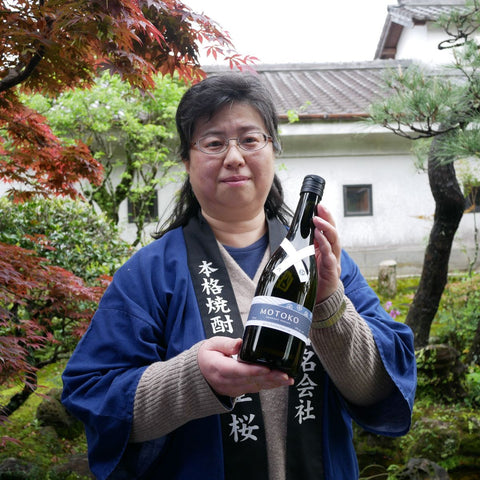
Welcome to the first edition of Female Frontrunners for Shochu Gumi! This is a theme that is dear to us at Umami Mart, as a women-led company: Yoko has been featuring women for the last six years of Sake Gumi, to coincide with Girl’s Day in Japan and International Women’s Day, both in March. We also take the opportunity to feature women makers in our shop – from tea and homewares to wellness products. It’s not just a myth: even in 2022, it’s hard to find women in any industry, and it brings us great joy to celebrate all the Female Frontrunners of Umami Mart.
Today we talk to Kyoko Yoshida, Director of Nishiyoshida Shuzo, maker of this month's Shochu Gumi selection Ark Jakuunbaku Barley Shochu.
How did you get into the shochu industry?
My family business was a shochu manufacturing company, but I pursued another career. After quitting my former job, I started helping out in the family business.
 Tanks at Nishiyoshida Distillery
Tanks at Nishiyoshida Distillery
What do you like most about shochu making?
It's interesting to blend and create a new taste.
Although shochu-making has been male-dominated, do you think more women are entering the field? What has changed to allow more women to enter shochu making?
According to literature, it is believed that sake breweries banned women after the Edo period. It was said that, "Women touch the nuka (fermented rice bran) at home, which affects the bacteria needed for sake brewing." Also, the work at the warehouse is very hard work and so it is a physical issue. Now that the mechanization of the site has progressed, I think it's less hard work than before.
At our company, we have female employees who work in the warehouse, and they also check for foreign substances when bottling. The acute attention to detail, unique to women, allows us to ship products with peace of mind. This is a very important position.
 Yoshida's grandmother and employees of the distillery
Yoshida's grandmother and employees of the distillery
What do you think is the most important step in shochu-making and why?
All processes interact to produce a quality shochu. The most important point that characterizes and distinguishes it from other spirits is the use of koji. In that sense, making koji and moromi is the most important thing. Distillation is the process that has the greatest impact on the character of shochu. The process of harmonization is storage and aging.
What kind of koji is used?
We usually use white koji, but for this bottle, Jakuunbaku, black koji is used.
Is this shochu vacuum distilled or atmospheric?
Atmospheric distillation
What kind of barley is used to make Jakuunbaku, and where is it grown?
We use a combination of Australian Nijo barley and Kyushu Nijo barley.
How long have you been making this shochu?
This shochu was launched in 2003.
What kind of vessel is this shochu aged? Stainless steel or ceramic? How long is it aged?
Enamel tank, aged for 2 to 5 years.
What different techniques are used to make this shochu?
In order to get the taste, we have devised the most traditional method, the non-filtration method. It brings out the individuality of wheat without any unpleasant taste.
Tell us a little bit about your town. How does your region influence your shochu-making?
It is a rice, wheat, and barley producing area. It is also blessed with water from two major rivers in the Tsukushi Plain: Chikugo River and Yabe River. We use underground water from the Hanamune River in the Yabe River system. The water taken by us has a lot of minerals and is suitable for sake brewing. We have strict quality control measures for the water.
How best to enjoy this shochu?
1. Hot water split 50/50: divide with hot water at a slightly higher temperature.
2. On the rocks: the scent is strong and the taste lasts a long time.
3. Mizuwari: 6 parts shochu to 4 parts water.
4. Ochawari: You can also drink it with tea.
What food pairings are best for this shochu?
Editor's note: As a former nutritionist, Yoshida sent us several recipes to pair with this bottle, including pork spareribs, chicken teriyaki, and maguro no tataki (seared tuna). See my recipe for Niku Miso by Yoshida here. It is excellent with Jakuunbaku!
 Niku Miso with crudites
Niku Miso with crudites
Was there a specific inspiration for the toji to make this shochu?
Attention was paid to unlocking the potential of barley itself. We also focused on making a punchy shochu. Not just a light and easy-to-drink spirit, but a self-assertive spirit.
What is makes this bottle extra special?
The oils that comes out during atmospheric distillation is not removed by filtration, but is removed by a special method. You can feel the sweetness while leaving the special aroma of wheat.
What is the meaning of Jakuunbaku?
Inspired by sutras by Aizen Myo, a Buddhist wisdom king, who is said to bring about family well-being and family happiness. We wanted to make a shochu that connects people to each other.
 A bottle of Jakuunbaku in Fukuoka
A bottle of Jakuunbaku in Fukuoka
Who designed the label?
Designed by Mr. Ryo Isobe, President and CEO of Isobe Liquor Store in Yamanashi Prefecture. It is a symbol representing "purity" in Sanskrit.
Any special behind-the-scenes stories or memories about making this shochu?
There are two limited versions of Jakuunbaku, Blue Label and Red Label. They are elusive, phantom shochus.
 Distillery staff and Yoshida holding a bottle of Tsukushi
Distillery staff and Yoshida holding a bottle of Tsukushi
It is the new year! What are some plans you have for 2022? Anything new or exciting?
We are making gin by applying similar methods and techniques of Jakuunbaku.
Is a rough filtration type with an emphasis on different tastes.
Photos courtesy of the distillery




Comments (0)
There are no comments for this article. Be the first one to leave a message!